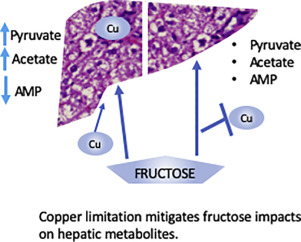The Journal of Nutritional Biochemistry ( IF 4.8 ) Pub Date : 2019-12-16 , DOI: 10.1016/j.jnutbio.2019.108316 Austin Morrell 1 , Brian P Tripet 2 , Brian J Eilers 2 , Megan Tegman 2 , Damon Thompson 1 , Valérie Copié 2 , Jason L Burkhead 1

|
This study aimed to characterize the impact of dietary copper on the biochemical and hepatic metabolite changes associated with fructose toxicity in a Wistar rat model of fructose-induced liver disease. Twenty-four male and 24 female, 6-week-old, Wister rats were separated into four experimental dietary treatment groups (6 males and 6 females per group), as follows: (1) a control diet: containing no fructose with adequate copper (i.e., CuA/0% Fruct); (2) a diet regimen identical to the control and supplemented with 30% w/v fructose in the animals' drinking water (CuA/30% Fruct); (3) a diet identical to the control diet but deficient in copper content (CuD/0% Fruct) and (4) a diet identical to the control diet but deficient in copper content and supplemented with 30% w/v fructose in the drinking water (CuD/30% Fruct). The animals were fed the four diet regimens for 5 weeks, followed by euthanization and assessment of histology, elemental profiles and identification and quantitation of liver metabolites. Results from 1H nuclear magnetic resonance metabolomics revealed mechanistic insights into copper modulation of fructose hepatotoxicity through identification of distinct metabolic phenotypes that were highly correlated with diet and sex. This study also identified previously unknown sex-specific responses to both fructose supplementation and restricted copper intake, while the presence of adequate dietary copper promoted most pronounced fructose-induced metabolite changes.
中文翻译:

铜可调节非酒精性脂肪肝疾病(NALFD)Wistar大鼠模型中的性别特异性果糖肝毒性。
这项研究旨在表征饮食铜对果糖诱发的肝病的Wistar大鼠模型中与果糖毒性相关的生化和肝脏代谢物变化的影响。将Wister大鼠24只,雄性,雌性,每只6周龄,分为24只,分为四个实验饮食治疗组(每组6只雄性和6只雌性),方法如下:(1)对照饮食:不含果糖和足够的铜(即,CuA / 0%果糖);(2)与对照组相同的饮食方案,并在动物的饮用水中添加30%w / v的果糖(CuA / 30%Fruct);(3)与对照饮食相同但铜含量不足(CuD / 0%Fruct)的饮食;(4)与对照饮食相同但铜含量不足且饮食中补充30%w / v果糖的饮食水(CuD / 30%果糖)。给动物喂食四种饮食方案持续5周,然后安乐死并进行组织学评估,元素概况以及肝代谢物的鉴定和定量。结果从1H核磁共振代谢组学通过鉴定与饮食和性别高度相关的独特代谢表型,揭示了对果糖对肝毒性的铜调节的机制。这项研究还确定了以前未知的对果糖补充和限制铜摄入的性别特异性反应,而适当的饮食铜的存在促进了最明显的果糖诱导的代谢物变化。











































 京公网安备 11010802027423号
京公网安备 11010802027423号